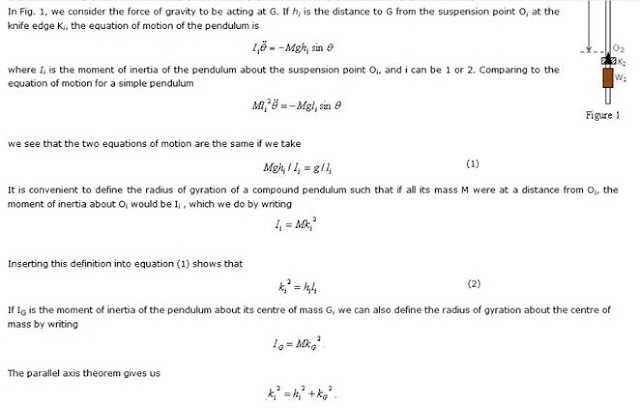Please Do Not Use This Reference
Material WORD FOR WORD View Terms Of
usage policy Page of this
site for more Info on how to use this site.
**Also See è How To Write Your Mechanical Laboratory Reports For Maximum
Performance**
Title: Kater’s Pendulum
Aim:
Apparatus:
Please Do Not Use This Reference
Material WORD FOR WORD View Terms Of
usage policy Page of this
site for more Info on how to use this site.
**Also See è How To Write Your Mechanical Laboratory Reports For Maximum
Performance**
THEORY:
GENERAL
A Kater's
pendulum is a reversible free swinging pendulum invented by British physicist and
army captain Henry Kater in
1817 for use as a gravimeter
instrument to measure the local acceleration of
gravity. Its advantage is that, unlike previous pendulum
gravimeters, the pendulum's centre of gravity and center of
oscillation don't have to be determined, allowing greater accuracy.
For about a century, until the 1930s, Kater's pendulum and its various
refinements remained the standard method for measuring the strength of the
Earth's gravity during geodetic surveys. It
is now used only for demonstrating pendulum principles.
Theory1
Kater’s pendulum, shown in Fig. 1, is a physical pendulum composed of a metal rod 1.20 m in length, upon which are mounted a sliding metal weight W1, a sliding wooden weight W2, a small sliding metal cylinder w, and two sliding knife edges K1 and K2 that face each other. Each of the sliding objects can be clamped in place on the rod. The pendulum can suspended and set swinging by resting either knife edge on a flat, level surface. The wooden weight W2 is the same size and shape as the metal weight W1. Its function is to provide as near equal air resistance to swinging as possible in either suspension, which happens if W1 and W2, and separately K1 and K2, are constrained to be equidistant from the ends of the metal rod. The centre of mass G can be located by balancing the pendulum on an external knife edge. Due to the difference in mass between the metal and wooden weights W1 and W2, G is not at the centre of the rod, and the distances h1 and h2 from G to the suspension points O1 and O2 at the knife edges K1 and K2 are not equal. Fine adjustments in the position of G, and thus in h1 and h2, can be made by moving the small metal cylinder w.
APPLICATIONS
Pendulums
are used to regulate pendulum clocks, and are used in scientific instruments
such as accelerometers and seismometers. Historically they were used as
gravimeters to measure the acceleration of gravity in geophysical surveys, and
even as a standard of length. The problem with using pendulums proved to be in
measuring their length.
A fine wire
suspending a metal sphere approximates a simple pendulum, but the wire changes
length, due to the varying tension needed to support the swinging pendulum. In
addition, small amounts of angular momentum tend to creep in, and the centre of
mass of the sphere can be hard to locate unless the sphere has highly uniform
density. With a compound pendulum, there is a point called the centre of
oscillation, a distance l from the suspension point along a line through the
centre of mass, where l is the length of a simple pendulum with the same
period. When suspended from the centre of oscillation, the compound pendulum
will have the same period as when suspended from the original suspension point.
The centre of oscillation can be located by suspending from various points and
measuring the periods, but it is difficult to get an exact match in the period,
so again there is uncertainty in the value of l.
THEORY 2
For
Procedures, See your Mechanical Laboratory Manual.
Please Do Not Use This Reference
Material WORD FOR WORD View Terms Of
usage policy Page of this
site for more Info on how to use this site
Observations
:-
1.
Applications:-
1.
PRECAUTIONS:
For Precautions, See General Laboratory Precautions
Please Do Not Use This Reference
Material WORD FOR WORD View Terms Of
usage policy Page of this
site for more Info on how to use this site.
**Also See è How To Write Your Mechanical Laboratory Reports For Maximum
Performance**









Blogger Comment
Facebook Comment